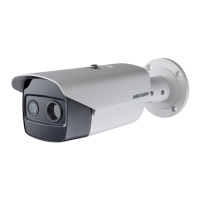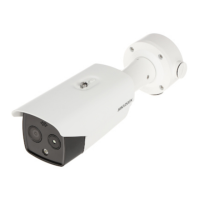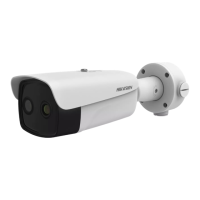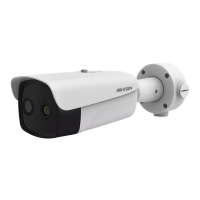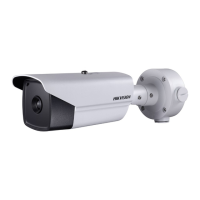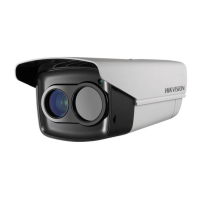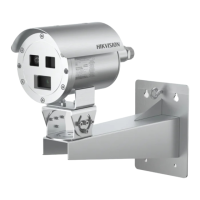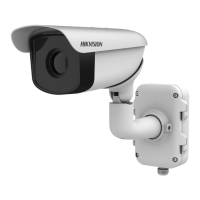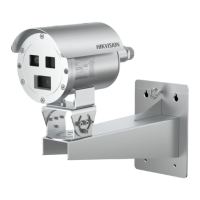
Do you have a question about the HIKVISION DS-2TD2608-2/QA/FP and is the answer not in the manual?
| Model | DS-2TD2608-2/QA/FP |
|---|---|
| Sensor Type | Thermal |
| Pixel Interval | 17 μm |
| Aperture | F1.0 |
| Image Sensor (Visible) | 1/2.7" Progressive Scan CMOS |
| Alarm | 1 input, 1 output |
| Focus | Fixed |
| Type | Bullet |
| Response Waveband | 8 μm ~ 14 μm |
| Thermal Sensitivity | ≤ 50 mK |
| Lens | 2 mm |
| Image Enhancement | AGC, 3D DNR |
| Image Display | 3D DNR |
| Video Compression | H.265/H.264 |
| Audio Compression | G.711u/G.722.1/G.726/MP2L2 |
| Protocols | TCP/IP, ICMP, HTTP, HTTPS, FTP, DHCP, DNS, DDNS, RTP, RTSP, RTCP, NTP, UPnP, SMTP, SNMP, IGMP, 802.1X, QoS, IPv6, Bonjour |
| Network Interface | RJ45 10M/100M Ethernet |
| Audio | 1 input, 1 output |
| Power | DC12V, PoE (802.3af) |
| Power Supply | 12 VDC ± 20%, PoE (802.3af) |
| Operating Temperature | -30 °C ~ 60 °C (-22 °F ~ 140 °F) |
| Dimensions | 221.2 mm × 94.9 mm × 82.5 mm |
| Weight | 770 g |
| Human Temperature Measurement Range | 30 °C to 45 °C (86 °F to 113 °F) |
| Human Temperature Measurement Accuracy | ± 0.5 °C (± 0.9 °F) |
Introduces the manual's content, purpose, and usage guidelines.
Outlines legal disclaimers, warranties, liability, and user responsibilities.
Defines the meaning of symbols like Danger, Caution, and Note used in the document.
Details safety precautions for connecting the device's power supply.
Covers battery safety, replacement, and disposal precautions to prevent hazards.
Provides critical safety instructions for properly installing the device.
Advises on protecting user information and data security when connected to networks.
Explains device maintenance and specifies recommended operating environments.
Instructions for handling emergencies like smoke, odor, or noise from the device.
Provides a general overview of the thermal camera's features and applications.
Explains the initial setup process for activating the device.
Step-by-step guide to activate the device using a web browser.
Instructions for activating the device using Hikvision's SADP software.
Configuration of TCP/IP settings including IPv4 and IPv6 for network operation.
Details on modifying device ports to avoid conflicts and ensure network access.
Explains how to map ports to access devices remotely through specified ports.
Setting up SNMP for network management and receiving alarm events.
How to access the device using Dynamic DNS (DDNS) for remote access.
Configuring PPPoE settings for ADSL dial-up network access.
Using the Hik-Connect mobile application for device monitoring and control.
Steps to enable the Hik-Connect service on the camera for remote access.
Explains how the device measures temperature and triggers alarms based on thresholds.
Details notices and flow charts for configuring temperature measurement.
Steps to configure parameters and rules for automatic temperature measurement.
Configuring the device to detect fire sources and smoke for prevention.
Steps to configure fire detection modes, parameters, and recommended scenes.
Settings for adjusting live view display parameters and function icons.
Managing window division, stream types, and enabling/disabling live view.
Adjusting lens focus, zoom, and iris for optimal image clarity.
Configuration of video parameters like stream type, encoding, and resolution.
Setting bitrate, video quality, frame rate, and compression standards.
Adjusting image quality using smoothing, VCA info display, and ROI encoding.
Fine-tuning image display with brightness, saturation, hue, sharpness, and contrast.
Configuring supplement light for night vision and BLC for backlight compensation.
Adjusting Wide Dynamic Range and White Balance for optimal image capture.
Applying Digital Noise Reduction and Defog functions for clearer images.
Customizing on-screen display and setting privacy masks for specific areas.
Configuring common storage paths like memory card, NAS, FTP, and cloud.
Steps for setting up memory cards and Network Attached Storage.
Operations for manual and scheduled video recording, including advanced settings.
Setting up continuous, alarm, or event-triggered recording schedules.
Starting/stopping manual recording and managing playback/download of videos.
Configuring manual or automatic picture capture and saving paths.
Configuring external alarm inputs and setting actions for exceptions.
Configuring scene change detection sensitivity and related alarm actions.
Defining custom time periods for device tasks and alarm linkage.
Configuring how the device responds to events or alarms.
Setting up alarm outputs, FTP/NAS uploads, and email notifications.
Configuring audible alarms and flashing lights for alerts.
Viewing device details and managing system logs for troubleshooting.
Importing and exporting device configuration files for batch setup.
Performing system maintenance tasks like exporting diagnostics and restoring defaults.
Upgrading device firmware and scheduling automatic maintenance restarts.
Configuring time zone, date, and daylight saving time settings.
Improving system security via network access controls and authentication.
Setting up RTSP and WEB authentication protocols for secure access.
Managing security audit logs and filtering IP addresses for access control.
Filtering MAC addresses and managing digital certificates for security.
Configuring HTTPS, QoS, and IEEE 802.1X for secure and efficient network communication.
Managing user accounts, permissions, and online user status.
Setting user levels, permissions, and managing user accounts.
A reference table listing common materials and their emissivity values.
Provides answers to common questions about the device.
